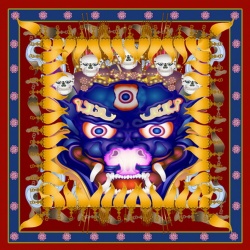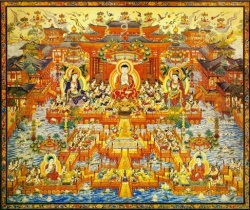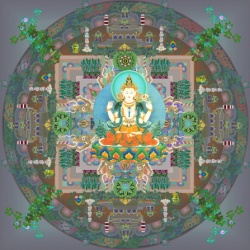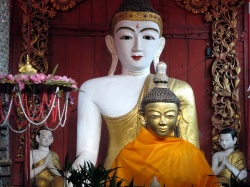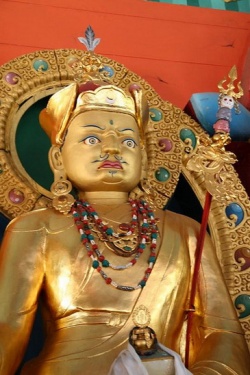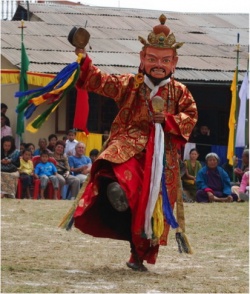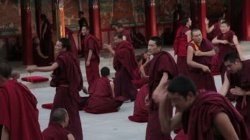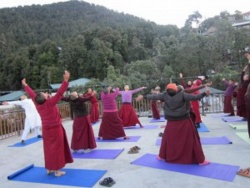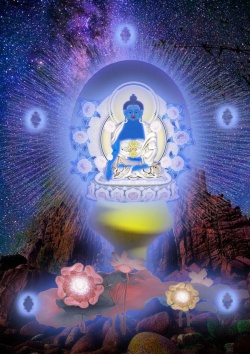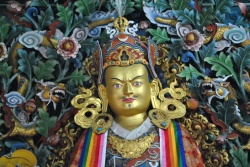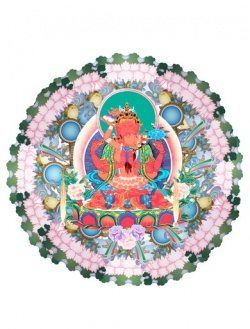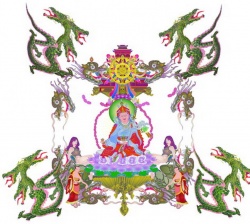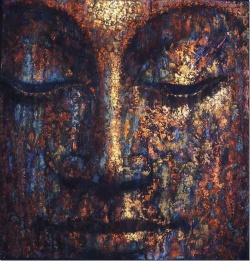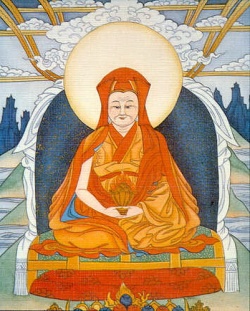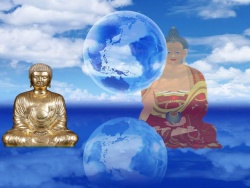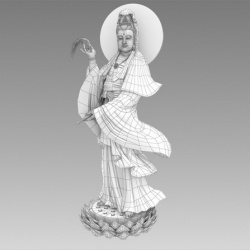Sakyabhiksu
In the Ku~a1)a period2 it is quite common for inscriptions to refer to the monastic fratemity either of the donor (when himself a monk) or of the recipients.
Later this is less common and we see instead a growing practice of making donatory inscriptions which do not specify any monastic schooI. In the case of donors new titles become prevalent, while in the case of recipients it becomes more normal to donate to a monastery rather than to a monastic lineage.
In two papers published around 1952 and 1962Masao Shizutani referred to this development and conjectured that 'the new title Sakyabhikkhu was of Mahayana origin'. He was no doubt aware that earlier scholars had taken it to mean 'Buddhist monk';4 so he adds the comment that: "This conjecture, however, may possibly be erroneous, and the title may have been devised in order to distinguish the Buddhist monks from the Jaina monks."5
This was followed up by H. Sarkar in 1968. Sarkar also believed that the Sakya-bhi~us could be identified as a distinct group, partly on the basis of their names.6 Then in an influential article first This article was initially stimulated by a paper given by Richard S. Cohen at the Spalding Symposium on Indian Religions, Oxford, 1999. It is now published: Cohen, Richard S., "Kinsmen of the Son: Sakyabhik~us and the Institutionalization of the Bodhisattva Ideal," HR 40 (2000). 2 There are a few definitely pre-Ku~aJ;la inscriptions and a number that cannot be dated. 3 Shizutani, Masao, "On the Sakyabhikshu as found in Indian Buddhistic Inscriptions," JIBS I, no. 2 (1953) (in Japanese); Shizutani, Masao, "Mahayana Inscriptions in the Gupta Period," JIBS X, no. I (1962).
4 BR s.v. Sakya, Sakyabhikshu ~ and Sakyabhik~ki. 5 Shizutani, "Mahayana Inscriptions," p. 356. 6 Sarkar, H., Studies in the Early Buddhist Architecture o/India, Delhi, 1966, pp. 106-8. The evidence on the basis ofthe names is not, however, very compelling. Nagoya Studies in Indian Culture and Buddhism: Sa",bha~a 23, 2003 © Department of Indian Studies, Nagoya University
published in 1979 Gregory Schopen developed the same idea in rather more detail. 7 To summarize the facts on which he based his position: 1. There is a donatory formula found in sources from around the fourth century and down to around the thirteenth century. 2. This formula involves the donation of good fortune (pU1;lya) to all beings, sometimes with an additional reference to the donor's family (kinship or monastic). In its full form it occurs with a phrase indicating that this is in order to obtain supreme knowledge (anuttara-jfiana).
3. The same donatory formula is found in the colophons of two Mahayana manuscripts from Gilgit and in the colophons of a number of post-tenth century Mahayana manuscripts, mostly from Nepal. 4. Many of the donors bear the titles of either Sakya-bhiksu or paramopasaka.
Schopen adds to the references to epigraphic materials initially collected by Shizutani and collects together a total of fifty seven passages. At the end of this artic1e he puts forward as a 'possible interpretation' the view that from the fourth century and throughout the Gupta period the followers of the Mahayana: "appear to have gone by the names Sakya bhiksu/paramopasaka - at least in inscriptions - and these names were never dropped."8
I believe this conclusion to be rnistaken. It seems in c1ear contradiction to the Hterary sources and is not c1early required even by the inscriptional evidence. In what follows 1 shall address first the usage of Sakiya-bhikkhu and Sakya-bhikkhu in Pali sources, then Sakya or Sakka by itself (i.e. without or separated from bhi~u), then Sakya-bhi~u and the earlier Pali Sakkaputtiya. Finally I discuss paramopasaka and then look at the donatory formul.a itself. Sakiya(-bhikkhu) and Sakya-bhikkhu in Pali To beg in with, let me turn to some Pali passages which have not as far as I know been noticed in this context.
Schopen, Oregory, "Mahayana in Indian Inscriptions," I-lJZ1 (1979). Ibid., p.l5.
In the commentary to the Cü/a-Narada-jataka9 there is a reference to a Sakiya-bhikkhu - a mother desirous of finding a husband for her daughter seeks to arrange for a Sakiya-bhikkhu to become enamoured of her daughter. The passage is clearly translated by A.L. Rowse:
"So her mother thought to herself: 'This my daughter is oJJull age, yet no one chooses her. I will use her as bait Jor a jish, and make one oJ those Sakiya ascetics come back to the world, and live upon him'." (Ja Trsl. IV 136).
The story is set in the time of the Buddha and it is clear from the context that the term simply means any bhikkhu who is a follower of the Buddha. Here it cannot possibly mean Mahayanist. It could conceivably mean a bhikkhu who is of the Sakiya (Sakya) clan, but that seems unlikely.
The exact date and authorship of the Jataka commentary is still unc1ear. Traditionally it is attributed to Buddhaghosa, but we should not necessarily take this too literally. Even if true, it right only mean that it was compiled by a group under Buddhaghosa's presidency.
More probably, we should take the attribution as simply meaning 'text of the school of Buddhaghosa, produced relatively elose to his time' and this is evident enough from its content.
The visit of Buddhaghosa to Ceylon is usually dated to the reign of Mahanama in the early fifth century A.D.but this dating is dependent upon a tradition not recorded untiI some seven hundred or so years later. So it is better to take Buddhaghosa's flomit as in the fourth century A.D. (but not earlier, assuming he is posterior to the extant DfpavaJtlsa).IO This would mean that the date of the Jataka commentary must He between then and the sixth century A.D.
9 Ja IV 219: Te kal/hani bhinnani ti idarrr Sattbö Jetavane viharanto thulla-kumarikapalobhanarrr arabbha kalhesi. Savatthi-vaslno kir , ekassa kulassa pannarasa-so/asa-vass'uddeslka dhita ahosl sobhagga-ppatta, na ca narrr koel varesl. Ath' assa mala eintesi: "mama dhita vaya-ppatta, na ca narrr koci varell. Ämisena maccharrr viya etaya ekarrr Sakiya-bhikkhurrr palobhetva uppabbajetva tarrr nlssayajivlssami" ti.
10 Kieffer-Pulz, Pelra, Die Sima. Vorschriften zur Regelung der buddhistischen Gemeindegrenze In alteren buddhistischen Texten, Berlin, 1992, pp. 163-167 dates the composition of the Vinaya eommentary to 386-87 A.D. But a date early in the fourth century cannot be ruled out. Compare also: Barua, B.M., "Buddhadatta and Buddhaghosa: Their Contemporaneity and Age," in Corrections 10 Gelger's Mahavarsa, eie.: A collection 01 monographs, ed. Buddhadatta, Ambalangoda, 1957; Buddhadatta, A. P., Correcl/ons olGeiger's Mahavamsa, eie: A collection olmonographs, Ambalangoda, Ceylon, 1957.
An even earlier Pali passage is found in the Apadana, a work included in the Canon but generally recognized to be one of the latest works admitted.11 The story concerns the Buddhist nun Bhadda Kesakut;l~ala (born in Rajagaha) who had previously ordained with the white-robed ones (seta-vattha).
They pulled out her hair with an implement; so the commentator Dharnmapala is probably correct in understanding them as being Jains (niga1J.tha). She leamed their doctrine (samaya) and lived alone, investigating it.
Then a human hand (from a cemetery) was cut off and left near her. Seeing the hand, she obtained the meditative object (nimitta) which is 'maggot-ridden' (pu!avakula = pu!avaka),12 Emerging from that experience, she was deeply moved (saltlvigga) and naturally asked her co-practitioners.
They replied that the Sakya monks (Sakyabhikkhavo) know about this thing (attha). The point of the story is that her experience was something unknown to the Jains and so she had to turn to the disciples of the Buddha.
So far as I know, this kind of cemetery meditation on the stages of decomposition of a corpse is not recorded as a Jain practice and may weIl have been typicaIly or even uniquely Buddhist at this time. So the spontaneous occurrence of an experience of this type could weIl lead to mention of the Buddhist practice.
The story is translated: Pruitt. William. The commentary on the verses o[ the Theris (Therigatha Aflhakatha Paramatthadipani VI) by Acariya Dhammapala. Oxford. 1998. p. 139ff.
12 This is a technical tenn for one of the mental objects of a type of meditation. Pruitt translates differently: "Seeing that sign. I received the hand that was full of maggots."
This is grammaticaIly possible, but does not make sense in the context of the story. We can take hatthafTI as object of dlsva. a1though against the order.
Or. hatthafTI and nimittafTI may be in apposition or a double accusative. In the laller case, translate: "Seeing <that>, I received (apprehended) that hand full of maggots as a meditative object (nimitta)".
This would be an early use of nimitta in !his way. but that is not too problematic in one of !he latest texts in the Canon.
In the flrst four Nikiiyas. we usually fmd: pu!avaka-safifia- (vII.). e.g. D III 226; S V 13If.; A 142; II 17; V 106; 310; cf. Dhs §264; Palis I 49; 95. In the commentarial literature the uncompounded pulavaka- (vi. pulu-) becomes normal. See especially Vism. .,
13 p! to Ps III 121: Bhikkhü ti Sakiya bhikkhü. maccha-maf/lsa-khadanato nildbhijati ti vadanti. fiaya-Iaddhe pi paccaye bhufijamana Afivaka-samayassa vlloma-gahitaya paccayesu kal,l!ake pakkhipitva khadanti ti vadanli. Eke pabbajita. ye savisesaf/l atta-kilamalhdnuyogam anuyulla; lalha hi le ka/Jlake vallenta viya honti 11 kal,l!aka-vuttika 11 vulla.
However this may be, it is quite clear that the expression Sakyabhikkhu here can only be intended to designate a Buddhist monk.
That it does in fact mean 'Buddhist monk' is further conftrmed by a third Pali occurrence. Commenting on a passage found in several places which describes the Ajivaka doctrine of the six abhijatis, Buddhaghosa refers to bhikkhus.
The {fka to his Majjhimagama commentary explains this as Sakiya bhikkhus. 13 EIsewhere in parallel passages the {fkas gloss this instead as 'bhikkhus in the Buddhasasana'.14 So there can be hardly any doubt that for the {fka-kara a Sakiya bhikkhu is precisely a Buddhist monk.
Sakya in Sanskrit texts
The earliest of the small number of extant Sanskrit textual passages given in the St. Petersburg Dictionary belong to the period around and just after the middle of the fIrst millennium AD.
These inc1ude passages in works of Varahamihira (fl. c. 550 AD.) and the slightly later Dal)~in. It is noticeable that the earliest of the inscriptions listed by Schopen belong to the period from the ftfth century to the seventh century AD. (One may be fourth century.)
A much earlier date is in any case perhaps unlikely in inscriptions, since this is mainly a Sanskrit usage and might not have been widely current in the period when Middle Indian was still normative for most Buddhist schools. Schopen points out that inscriptions containing the term Sakya-bhi~ are absent from the south and from the. north-west. So in fact its geographical distribution largely coincides with that of the Pudgalavadin schools.
In the Brhatsaltlhita Varahamihira refers to Sakyas and teachers (upadhyaya) together with Jains (arhata) and Jain ascetics in the fmal stages (nirgranthi).1S Probably the meaning here is in fact Sakyas and their teachers.
They are in any case two distinct items, since the list occurs in the treatment of a type of horary astrology in which signiftcance is -drawn from whoever the querent is looking at. So in 14 sv-pI I 290 (= Spk-p\ = Mp-t): Bhikkhü ti Buddha-sasane bhikkhu. 1S BS chap. 51, v. 21:
Sakyopadhyayarhata-nirgranthi-nimilla-nigama-kaivartailJ! caura-camüpali-val,lijaf/l das;-yodhapal,laslha-vadhyanamll (Kern read °nirgranlha-). 8vetambaras and Digambaras could also be meant here. but the reference is more probably to the distinction between grades of Jaina practice.
the case in question if the questioner looks at a Buddhist, the answer should concern a thief; if at his teacher, then the matter at hand concerns a military officer (camüpati); if at a Jain or a Jain ascetic, then it concerns a merchant or a slave-girl respectively.
It is not possible to tell from this passage alone whether Sakya here means a Buddhist in general or something more specific.
Most probably, however, since the Indian population at large did not identify itself as exclusively Vai~J}.ava or Buddhist or Saiva or Jain, but rather gave support on an ad hoc basis, it means both junior Buddhist monks and committed lay supporters (upasaka).
A later passage is rather clearer. In a chapter concerned with the setting up of images of deities, Varahamihira lists those who should do this in each case - Bhagavatas for (an image ot) Vi~J}.u, Magas for the Sun god, brahmins who wear ash for Siva, those familiar with the setting up of the malJ4ala for the goddesses, brahmins for Brahma, Sakyas for the compassionate one (sarva-hita) whose mind is at peace and naked ascetics for the Jinas,16 The tenth century commentator Bhanotpala specifies that the Sakyas are those who wear red (raktapata), a term which sometimes refers to Buddhist monks in texts of the period when Buddhist monks were still a living presence in most parts of India. 17 Moreover, he explains 'all-compassionate' as referring to the Buddha.18 So there can be hardly any doubt that Sakya here means 'Buddhist monk'.
V;~lJor Bhagavatan. Magarpj ca Savitul,. Sambhol, sa-bhasma-dvijan, matf1Jam api ma/;ujala-krama-vido, vipran vidur brahmanal" / Sakyan Sarva-hitasya sanla-manaso, nagnan Jinanalfl vidur. Ye yalfl devam upasrital, sva-vidhina tais tasya karya kriya. // (Kern read: matf1Jam api matj-malJifala-vldo.)
17 e.g. Kad 94f.: Sakyamuni-sösana-patha-dhaurayai raktapa/ail, (v.l. rakta-padail,); Ägamaifambara: Chap. 1 between vv. 23 and 24 where the snataka . humorously addresses the Buddhist monk: bho raklapa/a, Chap. 2 & 3 (I owe this reference to Csaba Dezsö who is preparing a new edition of this text); Nyayamaiijari: NM I 145; 641; 647; Bhagavata-puralJa: BhP 4.19.25 (upadharmefu nagna-rakta-pa!iidifU).
18 Sarva-hitasya Buddhasya santa-manaso jil'endriyasya Sakyan rakla-pa/an vidul,. 19 Pingree, David, ed., Yavanajataka ojSphujidhvaja, Cambridge, Mass., 1978, Vol. 11 p. 312. 20 AS chap. 3, 20.16: sakydjivakiidin vr~ala-pravrajitan deva-pitr-karye~u bhojayatal, satyo dalJifah.
In fact, an earlier mention of the word Sakya occurs in the Yavanajataka of Sphujidhvaja (YJ chap. 22, v. 4), composed in AD. 269/270. Here we learn that a strong Mars produces a Sakya-sramalJa 'with bad character'.
Indeed, David Pingree refers to aseries of seven later astrological writers, all dependent upon Sphujidhvaja.19 These variously refer in the same context to the Sakya-sramalJa, the raktapa!a, the Sakya-yogin and the Bauddhasraya.
Other planets when strong produce other types of religious practitioner. So there can be hardly any doubt that the expression is already current in this sense in the second century AD.
Indeed this is not the only earlier Sanskrit reference. In chapter two of the Arthasastra, we find a prohibition of the feeding at rites for ancestors of renunciants (vr~ala-pravrajita) such as Sakyas and Ajivakas .20
But probably the dating of the Arthasastra is controversial; so I will not attempt to make any use of this reference for dating purposes. We can also note a passage in Kumarila's Slokavarttika21 where the views of the Sakya are contrasted with those of the Vaise~ika and Sarpkhya schools. Interestingly, it is the specifically Vaibh~ika notion of the three kinds of asa'flskrta-dharma that is referred to.22
We also fmd a similar usage in Jain texts. The sixth century Jain commentator Jinabhadra has:
"lf the thought OJ the Jina is your standard, don 't reject substantiality, since, if substance is destroyed, destruction oJ everything would Jollow Jor you, just as Jor a Buddhis(. "23 Ko~yaryavadi, who completes this part of Jinabhadra's unfinished auto-commentary, explains that this means like a Buddhist because you accept only the modifications (paryaya-matra-grahitvat Sakyavat) and not substance (dravyartha).24
21 SV: Sabdanityaladhikaral)Q 21cd: Sakyasyapi Iv anaikanlal, ~alJika-vyaffrekibhil, ... 22 There are many further passages in later Sanskrit literature - too many to list here.
As examples we can note: Tallvasami~a: (TS: frrst kalJt!a) Sakyanalfl ~alJikalve; instructions for handling Buddhist and Jain monks on stage are given in the Natya-saslra: NS chap. 21 vv. 130 and 150; BhA: p. 51: Sal!lkhyasamaya e~a na Sakyasamaya~ and references to Sakkia-samal)Q- on pp. 9,46 and 49; Helaraja: VP p. 106f.; NM I 9; 45; 75; 195; 202; 344; 492; 526; 537; 568; II 298; 312.
There are a number of further occurrences in compounds in these and other texts, but I do not list those because there is sometimes ambiguity as to the meaning. 23 VA-bh 560:
Jaff Jina-malalfl pamalJalflto, ma davv '-alfhiyalfl pariccayasu. I Sakkassa va hotijato lalJ-lJasesavva-lJaso te 11 (2901) 24 Malvania (ibid. n. 3) cites a subcommentary which glosses Sakkassa as = Bauddhasya.
In the Sravakaprajnapti, a work attributed to Umasvati and in any case pre-fifth century, we find reference to speaking praise of Sakkas, etc. Haribhadra's eighth century Sanskrit commentary explains this as red monks (rakta-bhi~aval).25
Likewise, the relatively early Pi1'}q,a-nijjutti includes the Sakka in a list of five kinds of sama1}a.26 Jinadasa's Uttaradhyayana-cür1}i also mentions the Sakyas, as do various works of Haribhadra, Abhayadeva, and SiHÜlka.27 Later Prakrit texts also eite other examples of this usage.28
Sakyarya-bhi~u-saizgha and Sakyopasaka in epigraphie sources In a copper-plate grant of Guhasena of Valabhi, dated to the year 246 of the Gupta era, the king grants the revenues (cash and produce and labour) of a number of villages to provide the four requisites to the monks in the mahavihara of Du~~a, founded by the reverend Du~~a and situated in the neighbourhood of Valabhi.
More exactly, the monks are referred to as the noble monastic order of the Sakyas who belong to the eighteen nikayas and have come from many places.29 Later in the same epigraph the expression 'noble monastic order of the Sakyas' recurs. 30 The monastic university of Valabhi is known from a 25 ~P62:
para-pa~al!u!a-pasaTflsa SakMilJam iha vanna-vao u tehiTfl saha paricao 1'0 sa saTflthavo hoi nayavvo (88).
See also p. 200 where the commentary 10 verse 200 refers to: na Sakyady-upasaka-dharme. 26 Bollee, W.B., Materials for an Editio~ and Study of the PilJ(la- and Oha-nijjuttis of Ihe Svelambara Jain Tradition. Vol. 11 Text and Glossary, Stuttgart, 1994, p. 26. Niggantha Sakka Tavasa Geru10 AjTva pancaha samal)a (Y. 445,padas ab).
Accortling to Mehta, Mohanlal and Chandra, K. Rishabh, Agamie Index. Vol. 1. Prakrit Proper Names, Ahmedabad, 1970-72 (s.y. 1. samalJa), this is cited in the NiSitha-sülra-bhii~1O (Y. 4420) and in ten other commentarial works. See also PU 298.
27 Uuariidhya1Ona-ciirlJi, p. 190 (1933). Further references in Mehta and Chandra, op. eit. (s.Y. Sakka).
28 Somadeya (tenth century) in YT 11 249: Sugatakirtina Sakyena saha and in UA pp. 3 and 95; yv. 55; 76; 174; 309; 804. Vidyananda twice mentions the Sakya..sasana'(Ssp 27 and 29). See also Williams, Robert, Jaina Yoga. A Survey of Ihe Mediaeval Sravakacaras, London, 1963 p. 46; Balbir, Nalini, "lain-Buddhist Dialogue: Material from the Pali Scriptures," JPTS XXVI (2000) p. 27 (ratta-pa(la) and n. 74.
29 Valabhj-lala-sannivi~/a-Du#apada-karita-Du#a-mahavihare nana-dig-abhyagata~/adasanikaytibhyantara- Sakyaryya-bhi4u-saTflgha1O grasacchadana-sayyasana-glanapratyaya-bhai~ajytidy- upa1Ogiirllham ... See Bühler, I.G., "A Grant of King Guhasena of Valabhi," 1nd. Anl. IV, no. lune (1875), reYised in Bamett, Lionel D., "No. 30-Wala Plate ofGuhasena: the Year 246," EI XIII (1915-16).
30 ... 1Oto 'sy'ocilaya Sakyaryya-bhi~u-saTflgha-slhit{y]a bhuTfljala~ kr~ata~ ka{r~aya]lo va na kaiseil prati~edhe varttitav10m agami-bhadra-n.rpatibhis casmad-vaq!Sa-jair anilyany ai.fvaryyalJY asthiraTfl man~yaTfl samanyaTfl ca bhümi-da{na]-phalam avagacchadbhir ayam asmad-dayo 'numantavya~ paripalayilavyas ca ...
number of sources as a major centre of Buddhism in this period, espeeially but not exclusively for the non-Mahayana traditions, (and particularly those of the Pudgalavadin schools). In this context then the term Sakya again clearly me ans simply 'Buddhist'.
A similar expression occurs in another grant of the same sixth century king: 'the noble monastic order who belong to the eighteen nikayas and have come from many places'.31 In the former epigraph of this king he is referred to as a Saiva devotee (parama-mahesvara), whereas here he is designated as a Buddhist disciple (paramopasaka). It seems natural that a Saiva king (or a Saiva scribe working for a Saiva dynasty) might designate the monastic order as Buddhist (Sakya) and equally natural that, if he has become a leading Buddhist devotee, there would be no need to refer specifically to the Buddhist nature of the order to which he is donating.
We will refer again to this inscription, but for now we should also note the occurrence several times of the expression Sakyopasaka. It is found at Mathura, at Kuda and probably at AjaQta, although the last is in the uncertain form of 'Sakya u~aka'. The latter two inscriptions probably date to around the flfth and sixth centuries. As regards the one from Mathura, according to Lüders: "For palaeographic reasons the date of the inscription cannot be later than the beginning of the Ku~aJ,1 rule".32 This, then, with the passages in the ArthaSastra and the Apadana is probably the earliest occurrence of the word Sakya in this sense. In this particular case it is found on the pedestal of a seated Buddha from the site of a Buddhist monastery some twelve mHes west of the town of Mathura (outside the village of Anyör). The inscription records the gift of a Buddha image to the monastery 'for the happiness and benefit of all beings' (hita-sukh '-artha[ftlJ). We will have occasion to return to the occurrence of this type of formula when we turn to the donatory formulae which Schopen and Shizutani associate with the Mahayana.
31 ... nana-dig-abhyagata~!adasa-nikayabhyanlararyya-bhi4u-saTflghaya grasacchadanasayantisana- glana-bhai~ajytidy-kriy'olsarppalJarttham; see Bühler, G., "Grants from Valabhi," Ind. Ant. V, luly (1876), p. 207. 32 LUders, H., Malhura Inscriplions. Unpublished papers edited by Klaus L. Janert, Göttingen, 1961, p. 172.
Moving on to the textual occurrences of the term Sakya-bhi~u, we turn again to Varaharnihira. In a passage listing a number of persons and things under the rulership of the planet Mars, he includes Sakyabhi~ u. 33 It does not seem very likely that Mahayanists in particular would be under the rulership of Mars and in fact the commentator again explains as the red-robed ascetics.34 A similar notion recurs later in the Brhatsa1!lhita when we leam that activities connected with Buddhist monks (and various others inc1uding doctors and thieves) will be fruitful on a day presided over by the planet Mars.3S Needless to say, the association of the planet Mars with the colour red is very ancient.36
Manu-smrti (Man chap. IV, v.30) refers to pa~a1Jtjins among those who should not be honoured by brahmins. The commentator KullükabhaHa (twelfth or thirteenth century) explains tbis as referring to sakyabhi~u[kaJs, ~apa1Jakas, and so on. Earlier (and later) commentators make it certain that the reference is to Buddhist and Jain monks.37 We should note also the references to a Sakyabhi~ uki in the Dasakumaracarita (Dasa 79,1.11) and in the Padmaprabhrtaka (PP after v. 21). In the latter work a corrupt (du~ta) Sakyabhik~ u is a character (between verses 23 and 25).
The introductory stanzas to the treatise on the different doctrines (samaya-bheda) attributed to Vasumitra (extant only in translation) appear to contain a reference to him as a sakya-bhi~u. This would take the term back to the third or fourth century AD., the likely date of Vasurnitra, but in fact the reference is in one of the two stanzas which are absent from the fust Chinese translation.38 Since the three authentie stanzas simply state the objective of the treatise and contrast sharply with the two additional stanzas which name Vasumitra and refer to him in a way which is unlikely to have be~n original, we can 33 BS chap. 16, v. 14f.: kosa-bhavandgnihotrika-dhatvakara-Sakya-bhilqu-cauralJam. 34 Sakyo rakta-pata(ka)~ bhik~r yati~. Or, perhaps he intends to take Sakya- and bhik~u- as separate items. In any case, it is unlikely that Varahamihira meant that. 3S BS chap. 104, v. 61: anyac ca tiktaTfJ ka{u-dravya-külahipasarjita-svah kumara bhi~akSakyobhilqu-~ apavrtti-koseSa- [v!. °kauseya-l Sa{hyani si(d)dhyanti dambhas tatM.
36 e.g. Ptolemy (2nd century A.D.) (Tetra II 9), undoubtedly based upon older Greek sourees. 37 Medhatithi (ninth century): rakta-pata, nagna and carakas, ete.; Govindaraja: raktdmbarddi. 38 Bareau, A., "Trois traites sur les seetes bouddhiques attribues 11 Vasumitra, Bhavya et Vinitadeva. Premiere Partie," JA 242 (1954), p. 235 n.l; cf. SC p. I (eited from Cohen).
be confident that they are a later addition. Since they do appear to be found in the Tibetan version, we can be reasonably sure that they were added in India and prior to the time of Paramartha (sixth century AD.), but after the fust Chinese translation which was made between 385 and 431 AD. So this is arelevant source for the usage of sakya-bhi~u, dating to around the fifth century AD.
The farce Mattavilasavikrama, written by Mahendravikrama around 600 AD. has as one of Hs principal characters an entertainingly improbable Buddhist monk (residing in·the Raja-vihara at Kafieipura).39 He is usually referred to as a Sakya-bhik~u, but there is no indication of any Mahayana element; rather, he is certainly just a Buddhist monk in general.
At a later date in ninth century Kashrnir the Saiva writer Jayantabhana refers to the exponents of the Buddhist view as Sakyabhi~ us.40 The same author's philosophical drama Ägamatjambara introduces the Buddhist proponent and his disciple as a Sakya-bhi~u (and his upasaka) dressed in red.41 The monk in question clearly expounds Y ogacarin views at sorne points, but it is unlikely that Jayantabhana is distinguishing Mahayanists in particular. To this can be added a number of manuscript colophons identified (and discussed) by Schopen, including two from Gilgit.
Sakya-bhi~u, Sakkaputtiya and the Sakya lineage Richard Cohen draws attention to an additional Sanskrit reference to Sakya-bhi~u in the Sanghabhedavastu of the Mülasarvastivadin Vinaya.42 This presents the events preceding the newly-awakened Buddha's return to his home-town of Kapilavastu. Udayin (Kalodayin) is the last of aseries of messengers sent by King Suddhodana to invite bis son to return horne for the fust time and the first to aetually return.43 He is told by the Buddha to announce
40 NM I 664: Sakya-bhi~ava~ cilla-vasanaTfJ dharmam aca~ate; II 344: sarvatha Sakyobhik~ ülJaTfJ para-loko visaTfJ#hula~; 461; 694. 41 AI? chap. I (stage direction prior to v. 6): ... rakta-pata-saTfJvjta~ Sakya-bhi~ur upasakas cdgrala~.
42 Sailghabh 186.
43 This corresponds to the Pali commentarial story of Udayin(n)/Kajudayi(n). We should note here that, as often, material corresponding to that given in the Pali commentaries is found in the text of the Vinaya o[ the Mülasarvastivadins. Gregory Schopen has defended the relative antiquity of this Vinaya as against the general perception of most scholars that it is later than the
hirnself at the entraIice with the words: "a Sakya-bhilqu has come." And, if asked, he is to be told that there are other such Sakya-bhik$us (Le. the previous messengers who did not return). Cohen is obviously correct that in this context the term Sakyabhik$ u refers to a monk who is by birth a member of the Sakya clan.
He is right also to emphasize that sakya is a kinship term and makes a number of valid points in relation to this. He doesn't however pay any attention to the Pali sourees; so I would like to say a little about that. The name of the Buddha's clan occurs in the forms Sakka, Sakya and Sakiya in the Pali texts. For the most part the form Sakka occurs in the singular with the other two forms in the plural, although there are some exceptions.44 I take it that this is because the earlier mentions mostly refer to named individuals and that therefore Sakka is probably the oldest form. Given the general unreliability of etymologies of proper names, this perhaps leaves the historical correctness of the more Sanskritized forms in doubt, but I shall assurne here that the name of the clan corresponds either to Sanskrit Sakya or Sakya.45
Nearly forty times in the older texts of the Canon we meet the expression "the mendicant Gotama is a member of the Sakya clan, one extant Vinayas, e.g. Schopen, Gregory, 'The Monastic Ownership of Servants or Slaves: Local or Legal Factors in the Redactional History of Two Vinayas," The Journal o/Ihe Inlernalional Association 0/ Buddhist Srudles 17, no. 2 (1994). I do not fmd his arguments convinclng. To some extent, if I und erstand hirn correctly, his position is that the Vinayas generally were finalized at a somewhat later date than is usually supposed. Again I am not convinced. I would suppose that the Vinaya o/Ihe Mülasarvastivadins reached its present form at a rather late date. This of course does not mean that the components from which it was compiled are necessarily late. Nonetheless, Ü Schopen's position were to be accepted, then we should have to take the Vinaya 0/ Ihe Mülasarvasllvadlns as evldence for an early dating of some of the material in the Pali commentaries. But part of the story of KiiJudayi(n) is in any case quite old - cf. Th 57-36; Mvu
44 In canonical Pali Sakko- occurs in the singular apart from the locatlve plural form Sakkesu (found only in the Parlvara and the ekal?l samayal?l formula). Sakya- does not occur in the singular except onee as a v.l. The same is the case for Saklya except for Saklyo in the Mahavagga (Vin I 71; 99) with one occurrenee as a v.\. (Sn 423). But note the occurrenee in verse of Saklyasmil?l kule (Ap 11 573; 585), Saklye kule (Ap 11 589; 595; 602.) The form in compounds is usually Sakya-, apart from Sakly'-atrajo in Ap 11 504, Saklya-sambhava (Ap 11 592) and Saklyadasaka in Vin IV 181f. Saklya-mano at Vin 11 183 is probably erroneous (cf. 11 206).
4S The Cü{a-nlddesa offers three possible meanings for Sakko. I. The Lord is a Sakka i.e. one who has gone forth from that clan. 2. Sakka (cf. svako) means wealthy. The Lord is wealthy because he is rieh in good qualities. 3. Sakka (i.e. < sakra ..Jsak) means powerful and heroic, hence fearless. Nidd 11 99: Sakka 1I Sakko. Bhagava Sakya-kula pabbajllo 1I pi Sakko. Alha va, a(Nho mahad-dhano dhanava 1I pi sakko: lass' imanl dhanani, seyyalh 'Idal?l - saddha-dhanal?l siladhanal? l hlrl-dhanal?l ollappa-dhanal?l sUla-dhanal?l eaga-dhanal?l paiiiia-dhanal?l salipa!!hanadhanal? l sammappadhana-dhanal?l iddhipada-dhanal?l Indrlya-dhallal?l bala-dhallal?l bojjhangadhanal? l magga-dhanal?l phala-dhanal?l nibbana-dhanal?l. Imehi aneko-vidhehl dhana-ralanehi a44ho mahad-dhano dhanava ti pi sakko. Alha va, sakko pahu visavi alamatto süro viro vikkanlo abhirü aechambhi anulrasi apalay; pahina-bhaya-bheravo vigala-loma-hal?lso tI pi sakko.
who has gone forth from the Sakya family" (sama1}o khalu bho Gotamo Sakya-putto Sakya-kula pabbajito).46 The expression Sakyaputta here does not mean 'son of the Sakyan' (or similar), as it is sometimes taken. Rather °putta- at the end of a compound simply means male member of a clan or extended family. In fact, it is used occasionally of others too, e.g. Upananda, Hatthaka and Nanda, but it is clear that as the most famous member of the lineage, the Buddha soon becomes the Sakyaputta par excellence.
That being so, it is perhaps not surprising that the vrddhi formation from that: Sakkaputtiya- eika-) rapidly becomes the normal, if not the only, expression for Buddhist monk as opposed to, say, Jaina or Äjivaka monk. In the Vinaya-pifaka it occurs more than two hundred times.47 In the Sutta-pitaka more than sixty times.48 I take 'samalJo Sakyaputtiyo' as meaning 'mendicant connected with the famous member of the Sakya clan' i.e. 'folIower of the Sakyaputta'.
At some point this is further developed into the notion that Buddhist monks (or some of them) are the dhamma heirs of the Buddha and hence in some sense themselves members of the Sakya clan.49 46 See Ousaka, y" Yamazaki, M., and Norman, K.R., Index 10 Ihe Vinaya-pilaka, Oxford, 1996. Also in the recently discovered Baltimore Ms. of the Dirghdgama: e.g. twiee in the Amba~!ha-sülra (folio 410): and once in the Küfalal?l4ya-sülra (folio 401): sramal;lo Gaulama~ Sakya-pulra~ Sakya-kulat kesa-smasrv avalarya ka~ayalJi vaslral;ly acehadya samyag eva sraddhaya agarad anagarikaTtJ pravrajlla~.
47 The Index volume to the PTS edition (Ousaka, op. eil.) has 176 (including asakkapulliya-), but this is because Oldenberg's edition omits many repetitive passages.
48 The usage is also found in Sanskrit canonical material. See SHT Vol. I p. 11 (from an unidentified source): sramalJa Sakyaputriyal;lal?l (twiee) and six times in the Jivaka-sülra of the Dirghdgama (folio 433f.). Occasionally also in later Sanskrit works: Abhidh-k-bh 102 & 466; in Sirphasüri's (6'h or 71b century) Nyayagamanusarll;l; (NÄ 93): apratyalqal?l niladl-vi~ayal?l ea~uradl- vijfianal?l Sakyapulriyal?l bhranti-vld ili; in the Har~aearila: He (a) p. 246 = (b) chap. 8, p. 79: lena Sakyapulriyena; in the Yuktidipika: (early 81b century) YD 167.
49 This is typified by passages such as: Bhagavalo putto oroso mukhalo jalo dhammajo dhamma-nimmito dhamma-dayado no amisa-dayado. We should pemaps also note such expressions as Jlna-pulla at Vin 11 235; Bv 11 76; X 12; XXIII 8; Dip V I; 58; VII 49; Mhv LXXXXVIII 293?; Mil (12 occurrences); in the affhakalha literature (13 occurrenees); Vin-vn 2951; Nett-! 1; 355f.; MiI-! to Mil 119. There can be no doubt that this usually means 'Buddhist monk'; eolltra Schopen, Gregory, Bones, Slones, and Buddhist monks: Colleeted Papers on Ihe Arehaeology, Eplgraphy, and Texts 0/ Monaslie Buddhism in India, Honolulu, 1997, p. l09f.
Similarly, Buddha-pulla at Th p. 115 (concluding verse); Ap (four times); Mil (11 times); in the a!!hakalha (28 occurrenees but some refer literally to Rahula) and in later works. Also, SugalapUllana at Nidd-a 11 151. We would of course expect that just as the Sailgha is properly the ariyoslfn~ ha but mostly in practiee the bh!kkhu-sa~gha, so too these two terms refer ideally to the ariya dlsclples whether monk or lay, but m prachee to the monastic order who stand for that. This is explicit in the !ikas: Sv-pI 11 418 = PS-PI I 387 = Mp-! I 258: Yasma Sallhu-sasane pabbajilassa pabbajj'-upagamella Sakyapulliya-bhavo sampajayati, lasma Buddha-putta-bhavaTtJ dassenlo: asambhinnaya 1I adim aha.
It is noticeable that the tenn becomes less frequent in later texts. 50 There are perhaps two reasons for this. Firstly it is more natural to use such an expression in a pluralist situation Le. when nonBuddhist mendicants are frequent. With the growth of the Buddhist order that became less often the case, particularly in outlying areas such as Ceylon and the North-West. But one would expect variation over time depending on the local numbers of (e.g.) Jain monks. Secondly, the progress of Sanskritization and the increasing influence of Sanskritic stylistic considerations in some contexts probably made a tenn such as Sakyaputr(i)ya seem less attractive than the neater Sakya 'follower of the Sakya'.
paramopasaka in epigraphie sources An irnportant part of Schopen' s argument is that the tenns Sakyabhi~ u and paramopasaka refer respectively to monks and lay individuals belonging to the same group. Thls had always to be doubtful, given that he in fact cites a case from a colophon of the Pala period where someone is referred to as both - it is rather difficult to see how anyone can be simultaneously both a monk and a layman ! In fact several scholars have questioned whether the tenn paramopasaka can have this meaning.51
We already saw (above p. 8) that in two grants of the Maitraka king, Guhasena of Valabhi, paramopasaka replaces paramamaheSvara. This places the expression in elose relationship with a series of other epigraphic tenns which sirnilarly express a relationship of affiliation to a religious group or deity. Other examples inc1ude: parama-bhagavata, parama-saugata, parama-tathagata and so on. 52 Such expressions indicate either personal affiliation of the individual 50 It is not found in the Parivara nor in the Abhidhamma-pitaka. In fue Khuddaka-nikaya it is found only in Ud and once in Nidd I, in passages which are effectively cited from earlier works.
Although it occurs many times in post-canonical Pali, most occurrences are no doubt citatlons from !he earlier literature. However, it is possibly not seen so often in the very earliest canonical matenal.
51 Damsteegt, T., Epigraphical Hybrid Sanskrit: its rise, spread, characteristics and relationship to Buddhist Hybrid Sanskrit, Leiden, 1978, p. 257; Skilling, Peter, "A Note on the History of the Bhikkhuni-sangha (11), The Order of Nuns after the Parinirviil)a," w'F.B. Review XXX-XXXI (1993-4), n. 106 (and n. 10 which expresses scepticism as to whether Sakya indicates Mahayanist).
52 Sirear, D.C., Indian Epigraphical Glossary, Delhi, 1966, p. 235ff. gives references to these and also for parama-brahma/,1ya, parama-daivata, paramdditya-bhakta, parama-saura, and parama-vai~lJava.
or a familial affiliation to an i~ta-devata or something similar. In most cases this would not involve any kind of exclusivity. In some cases it may rather indicate how the scribe or a palace official wished to identify the donor.
In effect then, if we restrict our investigation to an early date (Le. prior to Pala times) there are just nine epigraphs which mention paramopasakaJOika from four locations: Samath, V alabhi, AjaI)~a and Katmandu. They are listed in Table One below. (Later occurrences which are known to me are listed in Appendix A.) The AjaI)la reference is, however, suspect;53 so we have in fact just two from Valabhi, five from Samath and one from Katmandu. According to Lüders (Ep. Ind.), the examples from Samath are definitely later than A.D.400.
According to the Chinese pilgrim Hsüan-tsang, the Samitiya (Sarpmatiya) school was very numerous at Valabhi. We know also from an inscription from Samath that the Samitiya school claimed to have replaced the Sarvastivadins at nearby VaraI)asi. So the data are quite compatible with the supposition that the tenn paramopasaka was initially current among the Pudgalavadin schools. This could be either a peculiarity of the terminology of this school or a regional usage from some area near Valabhi. Later it would have spread out from this and other Samitiya centres in the Pala domains to be more generally adopted.54 Very likely too some of the later branches of the Samitiya school adopted the Mahayana.
Literary sources too might suggest that the tenn paramopasaka is unlikely to have the kind of specificity that Schopen's argument requires. In the final chapter of the Har~a-carita. the sage Divakaramitra is depicted as attended by various devotees - followers of different religious traditions and animals of various kinds. Among the latter are "monkeys who are paramopasakas, committed to the three refuges and active in the (ritual) service of shrines, parrots skilled in the religion of the Sakya and providing instruction in the Kosa."55 There seems no reason to associate the monkeys with the 53 Richard Cohen reads: ... mocasaka{sya): Cohen, Richard S., "Problems in the Writing of Ajanta's History: The Epigraphie Evidence," I-IJ 40, no. 2 (1997), p.136. 54. Among the nineteen epigraphic occurrences of paramopasaka in inscrlptions from a later penod (see Appendix), two are from the Munger (Monghyr) Distriet of Bihar. This is the distriet identified by Skilling as the major Samitiya centre in later times. Skilling, Peter, "On the Schoolaffiliation of the 'Patna Dhammapada' ," JPTS XXIII (1997), p. lllf. Six more are again ff\lm Sarnath, while !Wo are from Nalanda where Samitiya monks were almost certainly present.
55 HC (a) p. 237: kapibhir api caityakal/l kurvalJais trayi-saralJa-parailJ paramopasakailJ,
Mahayana ! They are simply 'highly devoted'. We should also note here that the term maha-upasaka-fOika in Pali sources indicates a wealthy lay supporter of status.56
Shiwtan Schopen modern state donor dating iII infonnation
129 Sa i O(a) 16 U.P. (Samath) paramopasaka- characters of 4th KIrtti or 5th cent. A.O.
137 Sa i B(d)1 U.P. (Samath) paramopasakavi~ ayapati-
Suyattra
172 Gujarat the vihara at Gupta 216 =
(Valabhi) Valabhi made by A.0.534-5
paramopasika
Oudda 176 - Gujarat king Guhasena Gupta 248 = (Valabhi) A.0.566-7
142 Sa i 0(a)18 U.P. (Samath) paramopasaka characters of the Bhavarudra 6th century A.O. 156 Sa iv 19 U.P. (Samath) paramopasaka- characters of the (p. 127) Namnana 6th century A.O.
33 Aj iv a5* Maharashtra <para>mo[pa]sa ka Upendra
128 Sa i 0(a)15 U.P. (Samath) paramopasika Gupta characters Sulaksmana Katmandu paramopasaka 6th century Malligupta's wife Schopen 's argument
Schopen's argument depends on three separate points. He is aware that the part of his argument that depends on the donatory formula is sukair aRi SiiJcya-sösana-kusalaih . Kosam upadiSadbhis ca ... upasyamanam. The commentary glosses Sakya here as 'Buddhah'. Kane (HC (b) p. 73) has: caitya-karma kurvanals lri-saranapara/ ho . . .
56 Mi! l~f. Otherwise, it is found around ninety times in the allhakalha literature and in later, but not earher, wo!ks; cf. also maha-sellhi. Vjb 315 '" Sp-! III 57: Maha-upasaka 1I geha-samiko. SV-PI 11 349: Ayan ca nalO na kevala", Sakkass' eva, alha kho Maha-serthi-maha-upüslkanam pi holl yeva I/ dassenlo "Sakko deva-raja" 1/ Mim aha.
57 See Shiwtani, Masao, Indo Bukkya himei mokuroku. (Calalogue 0/ Indian Buddhisl inscripl/ons), Kyoto, 1979 for most of these. For the Nepalese inscription: Gnoli, Raniero, Nepalese inscriplions in Gupla characlers, Rome, 1956, p. 25 (on the base of an image of Avalokite§vara).
by itself weak; so he has tried to strengthen his thesis by seeking to identify a specifically Mahayanist group who usually refer to themselves, when lay, as paramopasaka and, when monks, as Sakyabhi~ u. The evidence I have cited above shows beyond doubt that the terms do not in themselves carry any Mahayanist meaning.
Paramopasaka is simply a term for a committed lay supporter of high standing, while Sakya-bhi~u is a term used regularly by nonBuddhists (and sometimes by Buddhists too) to refer to members of the Buddhist monastic order.
Of course, this doesn't completely rule out Schopen's position. Even if these two designations might be used by non-Mahayanists, they could still have been used also by a specific Mahayanist group at some point. There is no doubt that a few of the early epigraphs belonging to this supposed group are made by individuals who have adopted Mahayanist ideas. Mahayanists in the Pala period regularly refer to themselves as Sakya-bhi~us and occasionally as paramopasakas, but that may reflect simply the predominance of support for Mahayana in the North-East at a later date - especially among those wealthy enough to make substantial donations. Essentially, it is dangerous to read back evidence from Pala times to an earlier period and a different area.
Other explanations are equally possible. We might suppose that after the conflicts between Mahayanists and non-Mahayanists that seem to have taken place around the third century A.D. there was a re action against sectarianism and it simply became less fashionable to refer to specific schools of origin. In that case it is likely that the term 'Sakya-bhi~u' simply reflects a wish to be known simply as a 'Buddhist monk' rather than by any kind of specific nikaya affiliation. Such a notion gains strong support from the Valabhi inscriptions which refer specifically to the eighteen nikayas.
Schopen's thesis cannot then be sustained by the additional evidence he has put forward. Everything depends upon the donatory formula itself. This in fact was the earlier (and more cautious) position of Shizutani and Sarkar. And it is that which I now address.58 But before doing so, it is necessary to be more clear as to what we mean by Mahayanist.
58 Schopen revises his position on the formula slightly. See: Schopen, Bones, Siones, p. 32f.; 36ff. and nn.; 161, n.J; 202, n.97; 250nn.; 271n.; and Schopen, G., The Inscription on the Ku~an Image of Amitabha and the Character ofthe Early Mahayana in India," JIABS 10, no. 2 (1987), pp.
In the second century A.D. we do not yet have anything which we can truly call Mahayana Buddhism. We certainly have a literature to which the label Mahayanist can be attached, but even that is to some extent retrospective. Some of the works which are later to be the core literature of the Mahayana certainly exist at this time, but in earlier recensions which do not contain all of the distinctive features of later Mahayana. This is clearly shown by studies of the earliest Chinese translations and by surviving portions in Sanskrit of earlier recensions. Although these works are certainly extant at an earlier date, they are not the literature of any kind of separate institution. Rather they are apart of Mainstream Buddhism. That is to say a Buddhism, which is probably the ancestor of all subsequent fonns of Buddhism, that recognizes in principle that there are three distinct possible goals of Buddhist practice. But there is no sense in which they are seen as in conflict; they are simply part of a menu of choices. So typically in a larger Buddhist monastery we may suppose a wide range of options both for study and practice. This would include some of the various possibilities later included under the heading of Mahayana and many others that do not necessarily come under that rubric. Undoubtedly the larger part of the training and education of every monk would not be in any sense Mahayanist. Just as there wO\lld be monks specializing in particular areas such as vinaya or abhidhamma or jataka or other more speciflc fonns of literature or preaching or meditational exercises or ascetic practices or various kinds of ritual and organizational necessities, so there would be monks specializing in particular types of literature or practice or philosophy which from a later perspective we might call Mahayana.
We might expect that individual monks would typically have leamt something of a range of these but the exact mix would be a matter of individual predilection. Smaller monasteries would offer a more restricted range depending upon the avail~ble personnei; no doubt this would partly depend on the fashions and interests of a given time and place. What happened at a village level is less clear. We know little about the smallest Buddhist monasteries in ancient India because they have not left much trace in the archaeological record. Nor do we know the extent of a peripatetic mendicant presence, although it seems reasonable to suppose that wandering Buddhist monks would be found throughout South Asia. We can however be sure that no monasteries existed in isolation from the lay community.
This pattern remains the norm for a very long time. It is just this kind of model which is described by the Chinese pilgrim Fa-hsien in the flfth century A.D. The difference is only that in certain areas and monasteries study of the Mahayana texts was not usual. Clearly at some point and in some areas a need was feIt to call a halt to the new tendencies. Probably it was in the course of the third century A.D. that a measure of conflict arose between Mahayana and non-Mahayana.
But those who continued to study and develop Mahayana literature and practices certainly did so in an environment where this was only one part of a much larger range of monastic activities. Of course it was an ever-increasing part and one which eventually came to have a dominant role in the traditions developing in this way. But whether it had such a predominance in India much before the seventh century A.D. seems doubtful. Of course, it is in any case unlikely that developments occurred at the same speed in every part of the subcontinent.
If this model is correct, we cannot assurne that because a gift is made to monks of a named school this is necessarily non-Mahayanist. There is no reason to believe that any institutionally separate form of Mahayana existed in Ku~~a or Gupta times. Every 'Mahayana' monk was certainly supposed to be ordained in one or more of the old Vinaya traditions and had undoubtedly leamed and practised a great deal of standard Mainstream Buddhism.
The donatory formula
The earliest inscriptions extant often have no dedicatory fonnula, simply referring to somebody's 'dana",'. In Ku~al:la times, however, the normal practice is to say that the donation is 'for the happiness and benefit of all beings' (savva-satana", hita-sukhaya and similar). The compound 'hita-sukha-' is unusual in the Pali Canon59 and this exact expression is unknown in Pali literature, although hita-sukha- is quite frequent in the commentarialliterature.60 The sentiment, however, is normal enough. For example, the expression 'sympathetic to the 59 But cf. Sn 683: the 'Bodhisatta ... has been born in the human world for their happiness and benefIt' (manussa·loke hita-sukhataya; B' has hita-sukh'-althaya) and D IJI I 53f. (MahalakJchalJasUltanla). 60 But compare: Vism 325: lesalfl hila-sukhaya av;calddhillhana honli; cf. It-a 191; Cp-a 309: sabbam elalfl yalha-vullalfl dana-sampadalfl sakala-Ioka-hila-sukhaya parilJameli; Ras 192: lesalfl kulanalfl hila-sukhaya I; nimanlelVa with several further passages in the tfkas.
benefit of alt breathing and existent beings' (sabba-piilJa-bhütahitanukampin) occurs nearly fifty times in the Sutta-pi!aka, usually in the context of keeping the first precept. In later canonical and in commentarial works there is also a tendency to refer to developing metta to all beings (sabbe satta, etc.).61 In effect then the formula as it occurs in Ku~fu:1a inscriptions represents a straightforward development of early Buddhist ideas.
In apparent contrast, in post-Ku~a1).a inscriptions we find a new formula:
'This is the donation of so-and-so. May all beings have the good fortune in this <act of giving> in order to attain supreme knowledge'62 Tbe second part can also be rendered 'May the good fortune in this <act of giving> conduce to the attaining of supreme knowledge by all beings'. (I avoid the translation of pUlJyalpuiiiia as merit for reasons I have given elsewhere.63) Tbe [lIst translation appears more likely in terms of the historical evolution of the formula - normally puiiiia is dedicated to beings, rather than for a purpose.64 The second (prefer,red by Schopen) is perhaps more natural in terms of l~ter Sanskritic style. Nonetheless, the [lIst is almost certainly correct, glven that when there is a shortage of space, 'in order to attain supreme knowledge' is sometimes omitted.65 However, the formula is probably sufficiently ambiguous to be taken in different ways by different scribes and donors.
Tbere are two elements here: the notion that all beings should benefit and the idea that they should or might attain supreme knowledge. It is ljkely that debates about the exact operation of the act of dedicating one' s good fortune go back to an early date. Some sources try to restrict the benefit to petas. Clearly too, the idea that it is especially related to deceased parents or teachers has a long history. Moreover, the emphasis on all beings is already there in the Kusana version of the formula. While we might expect such a developme~t to be attractive to Mahayanists, it may long precede the formation of anything distinctively Mahayanist. It is also true that we simply do not
61 NOlably Palis II 130-135; cf. Vin II 110 = A II 73 = Ja II 144-8 (Khanda-jalaka)' Sn 145 (147) = Kh 8; plus additional passages with sabba-salla-. . . , 62 _ Deya-dhar(m)~~ ?a!!' .... Yad alra pUlJyarrr lat bhavalu sarv(v)a-satvanarrr (or sakalasatvanarrr) anllttara-)nanavaplaye. :! See: Cousins, L.S., "Good or Skilful ? Kusala in Canon and Commenlary," JBE 3 (1996). . I prefe~ not 10 refer 10 _t:a"sference, as the donor does not lose anYlhing. Rather the converse m fact; he gams yet more punna.
65 Cohen, "Kinsmen ofthe Son," p. 30, n. 68 gives six examples from Aj~la.
know the position of most of the early schools on this and related matters.
In any case, it is unlikely that ordinary Buddhists (and that would certainly include most Buddhist monks) would have paid much attention to theoretical issues here. Notably, dedication of puiiiia to all beings is not particularly rare in South-East Asian Buddhism today and this should not surprise uso After all, no-one seems to argue that dedicating merit to all beings is actually harmful and it seems a rather natural outflow of loving-kindness (metta). (Schopen hirnself does of course clearly recognize that there is nothing specifically Mahayanist about so-called merit-transference in itself.)
Tbe second element concems supreme knowledge. Whether or not this is evidence for the presence of the Mahayana depends on the exact force of the expression anuttara-jiiana 'unsurpassed knowledge'. As a compound it occurs both for the wisdom of the arahat and for the wisdom of a Buddha.66 So it is again probably sufficiently ambiguous to suit different purposes.
In conclusion
We can summarize the results of this investigation as follows: 1. Leaving aside its earlier and occasional use to refer to a member of the Sakya clan or to the Buddha himself, the term Sakya or Sakka is found in dated texts and inscriptions from the third century AD. and in a number of literary sources which are, or in some cases may be, earlier than that. It is found sporadically in a large number of Iater texts: in Jain lists of types of samalJa, in Jain, Saiva67 and Nyaya critiques of Buddhist views, in a number of astrological texts - there is no indication in any of this that it has a reference 66 (of a Buddha) Ps-pt II 6: anaflfla-sadharQ/;a-pllfliUinubhava-nibballo anullaraflal) adhigama-laddha-puravallako ca Bhagavalo ropa-kayo ; (of an arahaI) Pm-vn v.l043: laI/ha canullara-flalJarrr. saccanarrr pa{ivedhakarrr. samuccheda-ppahanena klesanusaya-sodhanarrr; cf. Pv-a 230: Julima Ii anllllaraya flalJa-jutiya jutima. Apart from flalJa, anullara occurs most often in relation to a Buddha, but quite often also in relation to an arahaI or the goal. In abhidhamma it is defined: Dhs § 1300: Kalame dhamma anullara ? Apariyapanna magga ca. magga-phalanl ca. asankhala ca dhatu - ime dhamma anullara. and §1614 Kalame dhamma anullara ? Callaro magga apariyapanna. callari ca samaflfla-phalani. nibbanafl ca - ime dhamma anullara.
67 For the use of Sakkiyar in Tamil Saiva literature to refer to Buddhists. see Nilakanta Sastri, N.A., "An Episode in the Hislory of Buddhism in South India," in B.C.Law Volume, ed.
D.R.Bhandarkar and others, Calcutta, 1945, Vol. I pp. 35-49; Vasudeva Rao, T.N., Buddhism in Ihe Tamil counlry, Annamalainagar, 1979, pp. 207-249; Schalk, Peler and Veluppi!!ai, A!vapi!!ai, Buddhism among Tamils in Pre-Colonial Tamilakam and J!am, Uppsala, 2002, pp. 75; 452.
to any specific type of Buddhism.
2. The more specific terms Sakya-bhikkhu, Sakiya-bhikkhu and Sakya-bhilqu are found in several Pali texts, in an astrological work, in two dramatic works, a Nyaya philosophical work and a commentary on Manu-smrti - again there is no reason to take it as referring to anything other than Buddhist monks in general. 3. It is c1ear that the use of the term Sakya- in this way develops naturally from the much earlier Sakkaputtiya-.
4. The term paramopasaka does not have any specific reference to a particular type of Buddhism.
5. Therefore Schopen's additions to the thesis of Shizutani do not appear well-grounded.
6. None of this conc1usively disproves either Shizutani's thesis i.e. that the donatory inscriptions are evidence of a distinct group who had adopted Mahayana or the alternative view that this was a group belonging to a specific school such as the Samitiyas. Such a group could have chosen to identify themselves as simply 'Buddhist monks' but this thesis too cannot be regarded as fmnly established on the basis of the available evidence.
7. We can· at least say that if we are dealing with a specific group and this is far from clear, their intention was precisely not to identify themselves as belonging to any specific Buddhist tradition. We should respect their wish.
ACKNOWLEDGMENT
Thanks are due to Richard Thomas, Peter Skilling and Csaba Dezsö for assistance on various points. Especial gratitude is due to Harunaga Isaacson for a number of additional references to Sanskrit texts and some helpful comments.
APPENDIX
inscriptions mentioning paramopasaka in the later period Eighteen epigraphs are listed here. Ten are certainly Mahayanist; several are fragmentary and may be Mahayanist. None are certainly non-Mahayanist, but most are from areas in or strongly influenced by the Pala territories where Mahayana predominates in this period.
Orissa (Neulpur)
83 grandfather of king Subha- R.D. Banerjl: 'Iatter half kara Is referred to as 'para- of the 8th century A.D.' mopasako'
Uttar Pradesh (Samath)
III
101 Sa i B(d)20 paramopasa[ka] 11 th century characters 103 Sa i B(e)1O [para]mopasaka 11 th century characters 107 Sa i B(e)1 paramopasaka 11th or 12th century characters
100 Sa I B(d)13 <ptf>ramopasaka 11th century characters Magadhiya-§ri-SaJnailka and sculpture 99 Sa iii °upasaka ?upasika Kalachuri Era 810 112 Sa Iv 25 (p. 128) paramopasika ?Pala period Bengal and Madhya Pradesh
Benii Bengal (Bela§a, MahayaiJa-yayina script of IOth- Tlppera DIstriet) paramopasaka 11th century I§vara-
19 (Kara) Queen ?I Oth century
Sri-Candalla-devi
14 MadP iii Madhya Pradesh pravara-Maha- Nagari of the (Gopalpur, jananujayi[nal) ) '11th or 12th Jabalpur Distriet) paramopasaka- century A.D.' kayastha- Bihar
57 Bih iii 53 (pp. Kartihar68 paramopaski Mafiju? Nagari characters of 238 & 247) the 9th to 11th centuries? 68 Bih iii 83 Kartihar paramopasaka- 11th century (ace. GOPalahinokaVa?69 Banerjl-Sastri)
25 Bih iii5 Kartihar pravara-Mahayana- year 3 of Vigrahaiaina- pramopasaka pala (III?) 68 Sixteen miles east of Gaya. 69 A donation was made by the same person in the year 32 of Rajyapala
Nai Bihar (Nalanda) paramopasika Gangüka palaeographieally 'eighth or ninth' P82 Naii29 Nalanda pravara-Mahayana- Mahipala (I?), year (p.232) yayina~ paramopasaka 11 Baladitya Bihic Kandi, Monghyr loeal prinee Samudra- (pts 3-4, pp. Distriet ditya; his father, prinee 7-8) Nanda was a pravara- Mahayananuyayin paramopasaka Bihiip.l46 Jaynagar, nr Maharoka, wife of Sirear: Gau~iya Lakhisarai, Santo~a, a pravara- eharacters of around Monghyr Distriet Mahayana-yayinya/JJj 12th century paramopasika 9 Bodhgaya pravara-Mahayana- Lak~mal)asena 74 or yayina~ 73 (= 1182 A.D.?) paramopasakasya 125 Guneriya, Patna paramopasa- Mahendrapala 9 Distr.
BIBLIOGRAPHY
Unless otherwise indieated, Pali texts used are the romanized editions published by the Pali Text Society (PTS). References to !ikas not yet published by the PTS are given to the Burmese edition as indieated on the VRI CD.
-a: a!!hakalha
-Pt: (poralJa-)!ika
-t: !ika
A: Angullaranikaya.
Abhidh-k-bh: Abhidharmakasabha~ya of Vasubandhu. Edited by Prahlad Pradhan, revised second edition with introduetion and indices by Aruna Haldar, Tibetan Sanskrit Works Series Vol. VIII. Patna: K.P. Jayaswal Research Institute, 1975.
AI;>: Ägamll{iambara of Jayantabhatta. See note 17 above. Ap: Apadana. ..
AS: ArlhaSaSlra attr. KautaJya. Edited by R.P. Kangle, University of Bombay studies: Sanskrit, Prakrit, and Pali I. Bombay: University ofBombay, 1960.
BhA: Bhagavadajjukiya of Bodhayana. Edited by P. Anujan Achan. Jayantamangalam: Paliyam Mss Library, 1925. . BhP: BhagavalopuralJo. BS: Brholsol/lhila ofVarahamihira.
(a) edited by H. Kern. Caleutta: Baptist mission press, 1865.
(b) edited by Sudhakara Dvivedi with the eommentary of Bha!!otpala, Part H, Vizianagram Sanskrit Series 12. Benares: E.I. Lazarus, 1897.
Bv: Buddhovol/Isa.
D: Dighonikayo. Dasa: DaSokumaracorilo of Dandin. Edited by H.H. Wilson. London: Society for the Publication of Oriental TextS: 1846. Dhs: DhommasongalJi. Dip: Dipaval/lSa.
HC: Harsocarita of Bana. (a) Cdited by P.V. kane, first edition. Bombay: P.V. Kane, 1918. 24 SÄKlYABHIKKHUISAKYABHIKKHUISÄKYABHIK.$U
(b) edited by KMinllth Pfu;l~urang Parab with the Commentary (Saßketa), third revised edition. Bombay: Tukaram Javaji, 1912.
Ja: Jalaka-o!!hakolha attr. Buddhaghosa.
Kad: Kadombori of BaI)a. Edited by Peter Peterson, Part I - Text, Bombay. Sanskrit Series XXIV. Bombay: Government Central Book Depöt, 1900.
Man:
KankhavilaralJi of Buddhaghosa.
Majjhimanikaya.
Manu-smrli. Edited by Jayantakrishna Harikrishna Dave with the eommentary of Kullükabha!!a, Volume 11 (Adhyayas 3-4), Bharaliya Vidya Series 33. Bombay: Bharatiiya Vidya Bhavan, 1975.
Mhv: Mahaval/lsa of Mahanama.
Mil: Milindapaiiha.
Mp: Manoralhapürani of Buddhaghosa. MVP: Ma/lavilasaprahasano of Mahendravikramavarman. Edited by N.P. Unni (with translation). Trivandrum: College Book House, 1974.
Mvu: Mahavaslu. Edited by E. Senart, Vol. III. Paris: Societe Asiatique, 1897. NA: NyayagamanusarilJi of Sil)lhasüri. Edited by Muni Jambüvijaya with the Nyayagamanusaril)i eommentary of Sil)lhasüri, 3 vols, Sn Atmanand Jaina Granthamala Serial 92. Bhavnagar: Sri Jain Atmanand Sabha, 1966. Nett: Ne!lipakarolJa.
Nidd I: Mahaniddesa.
Nidd 11: Cü!aniddeso. Edited by Bhikkhu J. Kashyap, Nalanda-Devanagari-Pali-Series. Nalanda: Pali Publication Board (Bihar Government), 1959. Nidd-a: Niddesa-a!!hakalha = Saddhommapajjolika of Upasena. NM: Nyayamaiijari of Jayantabhatta. Edited by K.S. Varadacharya, with his own
{ippalJi (Nyayasaurabha), 2 vols, Oriental Research Institute series 116 and 139. Mysore: Oriental Research Institute, 1969 and 1983.
Natyasaslro of Bharatamuni. Edited by M. Ramakrishna Kavi with the Abhinavabharati commentary, Vol. 111, Gaekwad's Orient al Series CXXIV. Baroda:
Orienta1 Institute, 1954. Patis: Pa{isambhidamaggo. PN: Pi1J4an1jjUlIi. Cited from W. B. Bollee, Materials for an Edition and Study of the Pil)~a-and Oha-nijjuttis of the Svetambara Jain Tradition. Vol. 11 Text and Glossary. Stuttgart: Pranz Steiner Verlag, 1994.
Padmaprabh{1aka of Sudraka. Edited by V.S. Agrawal. Bombay: Hindi Granthakaryalaya PraivetaJhp, 1959. Popaiicasüdoni of Buddhaghosa.
Pravacanosaroddhara of Nemicandra. Included in PrakarolJaratnakara, edited by Bhimasil)lha MaI)aka, pp. 1-568, Vol. 3. Bombay,1879. Pv: Pelaval/hu.
Ras: Rosavahini of Vedeha. Cited from the Burmese edition as given on the VRI CD. Sanghabh: Sanghabhedavas/u. Edited by Raniero Gnoli, Serie Orientale Roma Vol. XLIX. Rome:
Samayabhedoparacakra of Vasumitra. Edited by Enga Teramoto and Tomotsugu Hiramatsu. Kyoto, 1935.
SHT: Sanskrithandschriften aus den Turfanfonden. Edited by Ernst Waldschmidt, Walter Clawiter, and Lore Holzmann, Vol. I. Wiesbaden: Pranz Steiner Verlag, 1965. SUllanipala.
SavayapalJlJolli (Sravakaprajiiaplr) of Haribhadra. Edited by BaI Chandra Shastri. New Delhi: Bharatiya Jnanpith Publieations, 1981. Sarallhoppakasini of Buddhaghosa.
SatyaSasana-pari~a of Vidyananda. Edited by Gokula Candra Jain, Jilanpitha Mürtidevi Granthamala Sanskrit Granth 30. Benares: Bharatiya Jilanpitha Publication, 1964.
Sv: Sumongalavilasini of Buddhaghosa.
SV: Siokovar/lika of Kumarila. Edited by Svami Dvarikadasa Sastri, with the commentary (Nyayaratnakara) of Sn Parthasarathi Misra, Prachyabharati Series 10. Benares: Tara Publications, 1978.
Tetra: Telrabiblos of Ptolemy. Edited and translated by F.E. Robbins. The Loeb Classical Library. London: William Heinemann,1940, repr. 1971. Th: Therogatha. Thi: Therigatha. TS: TallVasami~a ofVacaspatimitra. Cited from the etext ofDiwakar Acharya.

